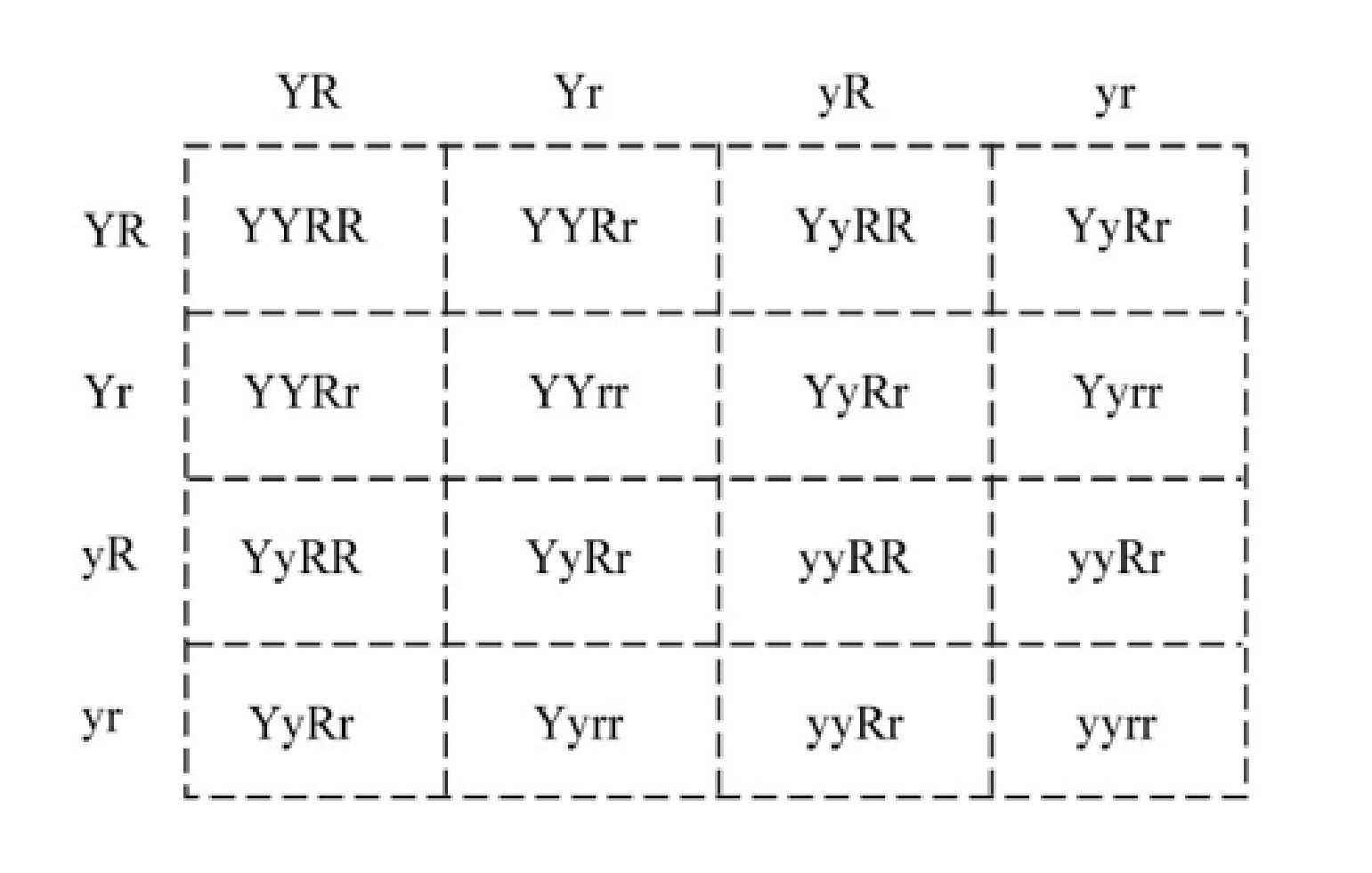
Concept explainers
DRAW IT Two pea plants heterozygous for the characters of pod color and pod shape are crossed. Draw a Punnett square to determine the
To draw:
The Punnett square to determine the phenotypic ratios of the offspring.
Introduction:
Punnett square is a tabular representation of the cross between the two species. It helps in determining the outcome of a particular cross and can help in estimating the genotypic as well as the phenotypic ratio.
Explanation of Solution
Pictorial representation: Punnett square depicting the dihybrid cross between the two pea plants are as follows:
Parental traits: Pod Colour: Dominant yellow (Y); recessive green (y)
Pod Shape: Dominant round (R); recessive wrinkled (r)

Fig.: 1 Punnett square depicting the dihybrid cross between the two pea plants of different characters.
The Punnett square is the diagrammatic representation to predict the outcome (phenotype and genotype) of the breeding experiment. In the given cross, pea plants that have two distinct characters are chosen, where one has round and yellow pods and the other one has wrinkled and green pods.
The cross provides a phenotypic ratio of 9:3:3:1 in a total of 16 outcomes. This means that there will be 4 different types of outcomes, namely round and yellow, round and green, wrinkled and yellow, and wrinkled and green. The genotypic ratio of the cross is 1:2:1:2:4:2:1:2:1, which means that there are 9 different types of genotype in this dihybrid cross.
Want to see more full solutions like this?
Chapter 11 Solutions
Campbell Biology in Focus (2nd Edition)
Additional Science Textbook Solutions
Biology: Life on Earth with Physiology (11th Edition)
Genetics: From Genes to Genomes
Campbell Essential Biology (7th Edition)
- How is a protein destined for the Endoplasmic Reticulum (ER), imported into the ER? Be concise.arrow_forwardFind out about the organisations and the movements aimed at the conservation of our natural resources. Eg Chipko movement and Greenpeace. Make a project report on such an organisation.arrow_forwardWhat are biofertilizers and mention the significancearrow_forward
- PCBs and River Otters: Otters in Washington State’s Green-Duwamish River have high levels of polychlorinated biphenyls (PCBs) in their livers. PCBs can bind to the estrogen receptors in animals and disrupt the endocrine system of these otters. The PCBs seem to increase the estrogen to androgen ratio, skewing the ratio toward too much estrogen. How would increased estrogen affect the river otter population? Based on your reading of the materials in this unit, what factors can affect fertility in humans? Explain how each of the factors affecting human fertility that you described can disrupt the human endocrine system to affect reproduction.arrow_forwardOther than oil and alcohol, are there other liquids you could compare to water (that are liquid at room temperature)? How is water unique compared to these other liquids? What follow-up experiment would you like to do, and how would you relate it to your life?arrow_forwardSelection of Traits What adaptations do scavengers have for locating and feeding on prey? What adaptations do predators have for capturing and consuming prey?arrow_forward
- Competition Between Species What natural processes limit populations from growing too large? What are some resources organisms can compete over in their natural habitat?arrow_forwardSpecies Interactions Explain how predators, prey and scavengers interact. Explain whether predators and scavengers are necessary or beneficial for an ecosystem.arrow_forwardmagine that you are conducting research on fruit type and seed dispersal. You submitted a paper to a peer-reviewed journal that addresses the factors that impact fruit type and seed dispersal mechanisms in plants of Central America. The editor of the journal communicates that your paper may be published if you make ‘minor revisions’ to the document. Describe two characteristics that you would expect in seeds that are dispersed by the wind. Contrast this with what you would expect for seeds that are gathered, buried or eaten by animals, and explain why they are different. (Editor’s note: Providing this information in your discussion will help readers to consider the significance of the research).arrow_forward
 Human Heredity: Principles and Issues (MindTap Co...BiologyISBN:9781305251052Author:Michael CummingsPublisher:Cengage Learning
Human Heredity: Principles and Issues (MindTap Co...BiologyISBN:9781305251052Author:Michael CummingsPublisher:Cengage Learning Concepts of BiologyBiologyISBN:9781938168116Author:Samantha Fowler, Rebecca Roush, James WisePublisher:OpenStax College
Concepts of BiologyBiologyISBN:9781938168116Author:Samantha Fowler, Rebecca Roush, James WisePublisher:OpenStax College
 Biology Today and Tomorrow without Physiology (Mi...BiologyISBN:9781305117396Author:Cecie Starr, Christine Evers, Lisa StarrPublisher:Cengage Learning
Biology Today and Tomorrow without Physiology (Mi...BiologyISBN:9781305117396Author:Cecie Starr, Christine Evers, Lisa StarrPublisher:Cengage Learning Biology 2eBiologyISBN:9781947172517Author:Matthew Douglas, Jung Choi, Mary Ann ClarkPublisher:OpenStax
Biology 2eBiologyISBN:9781947172517Author:Matthew Douglas, Jung Choi, Mary Ann ClarkPublisher:OpenStax





